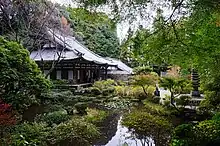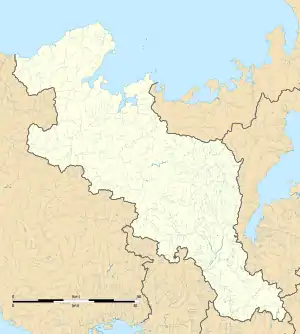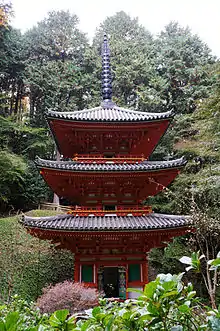| Gansen-ji | |
|---|---|
岩船寺 | |
 The main hall and pond | |
| Religion | |
| Affiliation | Buddhist |
| Sect | Shingon Risshu |
| Prefecture | Kyoto |
| Location | |
| Municipality | Kizugawa |
| Country | Japan |
 Shown within Kyoto Prefecture  Gansen-ji (Japan) | |
| Prefecture | Kyoto |
| Geographic coordinates | 34°43′12.9″N 135°53′8.9″E / 34.720250°N 135.885806°E |
| Website | |
| gansenji | |
Gansen-ji (Japanese: 岩船寺) is a Japanese Buddhist temple of the Shingon Risshu sect in the city of Kizugawa in Kyoto Prefecture, Japan.
The temple is known for its hydrangea gardens, and is the fifteenth of the twenty-five Kansai flower temples,[1] a multi-sect association of twenty-five Japanese Buddhist temples in the Kansai region that are known for their flower and foliage displays.[2]
The temple is part of the Tono Magaibubu Cultural Property Environmental Conservation Area[3] and is part of two Japanese Buddhist pilgrimages. The temple is fourth of the eighteen ancient Shingon temples[4] and is the 129th of the Kansai region's 152 shrines of the Shinbutsu Pilgrimage.[5]
History
According to the Gansen-ji Engi (Japanese: 岩船寺縁起, lit. 'Gansen-ji's Origin') compiled in 1632, Gansen-ji was built in 729 by the Buddhist priest Gyōki by order of Emperor Shōmu.[6] Much of it was burned down during the Jōkyū War in 1221 before being rebuilt in 1311. After being destroyed again by fire, donations were made for its reconstruction by Tokugawa Ieyasu and Tokugawa Hidetada, and was rebuilt between 1624 and 1643 during the Kan'ei era.[7]
To celebrate the 2600th anniversary of Japan's founding, a gagaku musical group called the Garyōkai held a concert at Gansen-ji on December 7, 1940. The event included classical music, noh dances, and a special Japanese tea ceremony.[8]
Artifacts

Gansen-ji has a wooden Japanese pagoda, two stone pagodas, and a stone chamber that have each been recognized as Nationally Designated Important Cultural Property.[9][10][11][12]
The temple's three-storied wooden pagoda was built in 1442 during the Muromachi period and was designated as a Nationally Designated Important Cultural Property in 1889.[9]
The thirteen-story stone pagoda and the gorintō were both built from between 1275 and 1332 during the late Kamakura period and were each designated Nationally Designated Important Cultural Property in 1952.[10][11] The temple's stone chamber, housing a stone statue of Buddha, was built in 1312 in the late Kamakura period and was also designated a Nationally Designated Important Cultural Property in 1952.[12]
Among the cultural artifacts within the temple is a 275-centimetre-tall (9.02 ft) wooden seated statue of Amida Nyorai that was created in 946[13][14] during the Heian period.[15]
References
- ↑ "第15番 岩船寺" [No. 15 Gansen-ji]. hana25.jp (in Japanese). Archived from the original on October 31, 2022. Retrieved October 30, 2022.
- ↑ "関西花の寺二十五カ所" [Twenty-five flower temples in Kansai]. hana25.jp (in Japanese). Archived from the original on October 31, 2022. Retrieved October 30, 2022.
- ↑ "お勧めスポット>当尾の石仏" [Recommended Spots > Stone Buddha of Tono]. Kizugawa City (in Japanese). Archived from the original on July 7, 2022. Retrieved June 19, 2022.
- ↑ "第四番 岩船寺" [No.4 Gansenji Temple]. Buttoukoji.com (in Japanese). Archived from the original on May 11, 2021. Retrieved June 19, 2023.
- ↑ "京都-神仏霊場会" [Kyoto - Shinbutsu Sacred Sites]. ShinbutsuReijou.net (in Japanese). Archived from the original on July 4, 2022. Retrieved June 19, 2022.
- ↑ "岩船寺" [Gansen-ji]. 奈良県 [Nara Prefecture] (in Japanese). Archived from the original on July 9, 2022. Retrieved June 19, 2023.
- ↑ "岩船寺" [Gansen-ji]. Gansenji.or.jp (in Japanese). Archived from the original on June 14, 2023. Retrieved June 19, 2023.
- ↑ Naoko, Terauchi (2016). "An Alternative Gagaku Tradition: The Garyōkai and Modern Osaka". In de Ferranti, Hugh; Tokita, Alison (eds.). Music, Modernity and Locality in Prewar Japan: Osaka and Beyond. Ashgate Publishing. p. 262. ISBN 9781317091622.
- 1 2 "岩船寺三重塔" [Gansen-ji's Three-storied Pagoda]. 国指定文化財等データベース [Database of Nationally Designated Cultural Properties] (in Japanese). Retrieved June 19, 2023.
- 1 2 "岩船寺十三重塔" [Gansen-ji's Thirteen-storied Pagoda]. 国指定文化財等データベース [Database of Nationally Designated Cultural Properties] (in Japanese). Retrieved June 19, 2023.
- 1 2 "岩船寺五輪塔" [Gansen-ji's Gorintō]. 国指定文化財等データベース [Database of Nationally Designated Cultural Properties] (in Japanese). Retrieved June 19, 2023.
- 1 2 "岩船寺石室" [Gansen-ji's Stone Chamber]. 国指定文化財等データベース [Database of Nationally Designated Cultural Properties] (in Japanese). Retrieved June 19, 2023.
- ↑ Tokyo National Museum (1957). Sculpture. Tokyo: Tōto Shuppan. pp. X.
- ↑ Minamoto, Toyomune; Henderson, Harold Gould (1935). An Illustrated History of Japanese Art. Kyoto: K. Hoshino. p. 50. OCLC 1082861.
From an inscription on the inside of the head of this statue we learn that it was made in 946.
- ↑ The Japan Architect. Vol. 39. Shinkenchiku-Sha. 1964. p. 92.
External links
 Media related to Gansenji at Wikimedia Commons
Media related to Gansenji at Wikimedia Commons- Official website (Japanese)